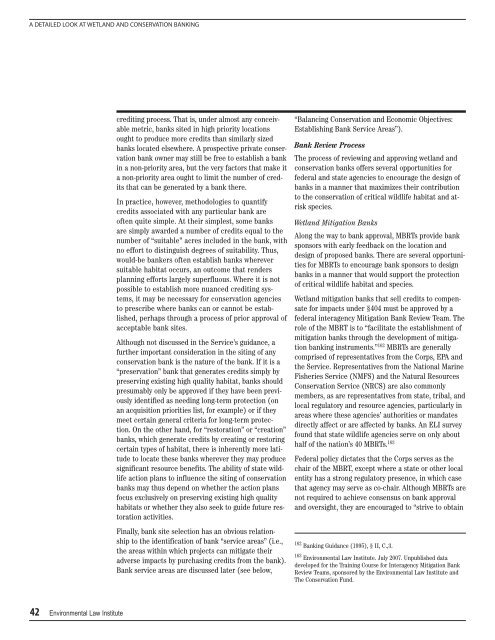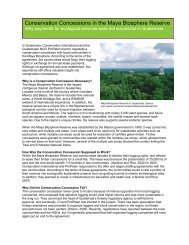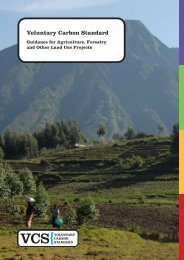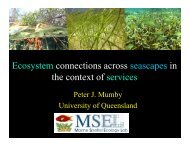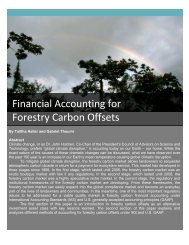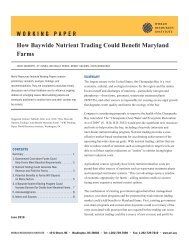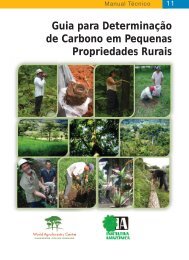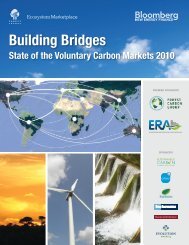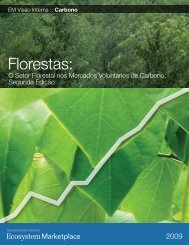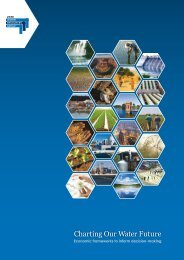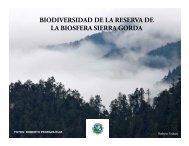Design of US Habitat Banking Systems to Support the Conservation ...
Design of US Habitat Banking Systems to Support the Conservation ...
Design of US Habitat Banking Systems to Support the Conservation ...
Create successful ePaper yourself
Turn your PDF publications into a flip-book with our unique Google optimized e-Paper software.
A DETAILED LOOK AT WETLAND AND CONSERVATION BANKINGcrediting process. That is, under almost any conceivablemetric, banks sited in high priority locationsought <strong>to</strong> produce more credits than similarly sizedbanks located elsewhere. A prospective private conservationbank owner may still be free <strong>to</strong> establish a bankin a non-priority area, but <strong>the</strong> very fac<strong>to</strong>rs that make ita non-priority area ought <strong>to</strong> limit <strong>the</strong> number <strong>of</strong> creditsthat can be generated by a bank <strong>the</strong>re.In practice, however, methodologies <strong>to</strong> quantifycredits associated with any particular bank are<strong>of</strong>ten quite simple. At <strong>the</strong>ir simplest, some banksare simply awarded a number <strong>of</strong> credits equal <strong>to</strong> <strong>the</strong>number <strong>of</strong> “suitable” acres included in <strong>the</strong> bank, withno effort <strong>to</strong> distinguish degrees <strong>of</strong> suitability. Thus,would-be bankers <strong>of</strong>ten establish banks whereversuitable habitat occurs, an outcome that rendersplanning efforts largely superfluous. Where it is notpossible <strong>to</strong> establish more nuanced crediting systems,it may be necessary for conservation agencies<strong>to</strong> prescribe where banks can or cannot be established,perhaps through a process <strong>of</strong> prior approval <strong>of</strong>acceptable bank sites.Although not discussed in <strong>the</strong> Service’s guidance, afur<strong>the</strong>r important consideration in <strong>the</strong> siting <strong>of</strong> anyconservation bank is <strong>the</strong> nature <strong>of</strong> <strong>the</strong> bank. If it is a“preservation” bank that generates credits simply bypreserving existing high quality habitat, banks shouldpresumably only be approved if <strong>the</strong>y have been previouslyidentified as needing long-term protection (onan acquisition priorities list, for example) or if <strong>the</strong>ymeet certain general criteria for long-term protection.On <strong>the</strong> o<strong>the</strong>r hand, for “res<strong>to</strong>ration” or “creation”banks, which generate credits by creating or res<strong>to</strong>ringcertain types <strong>of</strong> habitat, <strong>the</strong>re is inherently more latitude<strong>to</strong> locate <strong>the</strong>se banks wherever <strong>the</strong>y may producesignificant resource benefits. The ability <strong>of</strong> state wildlifeaction plans <strong>to</strong> influence <strong>the</strong> siting <strong>of</strong> conservationbanks may thus depend on whe<strong>the</strong>r <strong>the</strong> action plansfocus exclusively on preserving existing high qualityhabitats or whe<strong>the</strong>r <strong>the</strong>y also seek <strong>to</strong> guide future res<strong>to</strong>rationactivities.Finally, bank site selection has an obvious relationship<strong>to</strong> <strong>the</strong> identification <strong>of</strong> bank “service areas” (i.e.,<strong>the</strong> areas within which projects can mitigate <strong>the</strong>iradverse impacts by purchasing credits from <strong>the</strong> bank).Bank service areas are discussed later (see below,“Balancing <strong>Conservation</strong> and Economic Objectives:Establishing Bank Service Areas”).Bank Review ProcessThe process <strong>of</strong> reviewing and approving wetland andconservation banks <strong>of</strong>fers several opportunities forfederal and state agencies <strong>to</strong> encourage <strong>the</strong> design <strong>of</strong>banks in a manner that maximizes <strong>the</strong>ir contribution<strong>to</strong> <strong>the</strong> conservation <strong>of</strong> critical wildlife habitat and atriskspecies.Wetland Mitigation BanksAlong <strong>the</strong> way <strong>to</strong> bank approval, MBRTs provide banksponsors with early feedback on <strong>the</strong> location anddesign <strong>of</strong> proposed banks. There are several opportunitiesfor MBRTs <strong>to</strong> encourage bank sponsors <strong>to</strong> designbanks in a manner that would support <strong>the</strong> protection<strong>of</strong> critical wildlife habitat and species.Wetland mitigation banks that sell credits <strong>to</strong> compensatefor impacts under §404 must be approved by afederal interagency Mitigation Bank Review Team. Therole <strong>of</strong> <strong>the</strong> MBRT is <strong>to</strong> “facilitate <strong>the</strong> establishment <strong>of</strong>mitigation banks through <strong>the</strong> development <strong>of</strong> mitigationbanking instruments.” 162 MBRTs are generallycomprised <strong>of</strong> representatives from <strong>the</strong> Corps, EPA and<strong>the</strong> Service. Representatives from <strong>the</strong> National MarineFisheries Service (NMFS) and <strong>the</strong> Natural Resources<strong>Conservation</strong> Service (NRCS) are also commonlymembers, as are representatives from state, tribal, andlocal regula<strong>to</strong>ry and resource agencies, particularly inareas where <strong>the</strong>se agencies’ authorities or mandatesdirectly affect or are affected by banks. An ELI surveyfound that state wildlife agencies serve on only abouthalf <strong>of</strong> <strong>the</strong> nation’s 40 MBRTs. 163Federal policy dictates that <strong>the</strong> Corps serves as <strong>the</strong>chair <strong>of</strong> <strong>the</strong> MBRT, except where a state or o<strong>the</strong>r localentity has a strong regula<strong>to</strong>ry presence, in which casethat agency may serve as co-chair. Although MBRTs arenot required <strong>to</strong> achieve consensus on bank approvaland oversight, <strong>the</strong>y are encouraged <strong>to</strong> “strive <strong>to</strong> obtain162 <strong>Banking</strong> Guidance (1995), § II, C.,3.163 Environmental Law Institute. July 2007. Unpublished datadeveloped for <strong>the</strong> Training Course for Interagency Mitigation BankReview Teams, sponsored by <strong>the</strong> Environmental Law Institute andThe <strong>Conservation</strong> Fund.42 Environmental Law Institute


